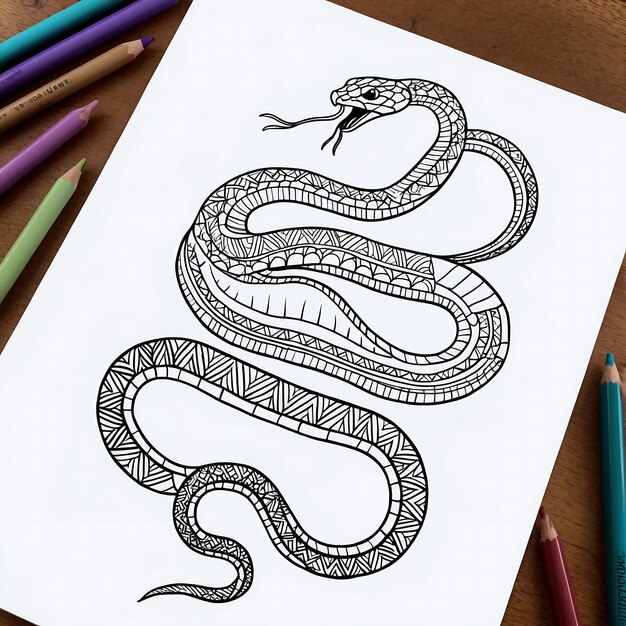Explore this comprehensive guide to Drawing:bxv6evbk8ta= Snake, featuring techniques, tips, and inspiration for artists of all levels. Unleash your creativity today!
Introduction
Drawing:bxv6evbk8ta= Snake can be an enjoyable and rewarding experience for artists of all skill levels. In this comprehensive guide, we will explore various techniques, styles, and tips that can help you create captivating snake drawings. Whether you are a beginner looking to learn or an experienced artist seeking to refine your skills, this guide covers everything you need to know about drawing snakes. So, let’s embark on this artistic journey, and by the end, you will have the confidence to create your own stunning snake illustrations.
Understanding the Anatomy of a Snake
Before you start drawing a snake, it is essential to understand its anatomy. Snakes have a unique body structure that differentiates them from other animals. Their elongated, flexible bodies consist of a head, a long body, and a tapered tail. Additionally, snakes possess various features such as scales, eyes, and a forked tongue. By studying the anatomy of snakes, you will gain a deeper appreciation for their form, enabling you to represent them accurately in your drawings. Moreover, you can choose to focus on specific types of snakes to further enhance your understanding of their characteristics, such as the distinctive features of a rattlesnake or the elegant shape of a boa constrictor.
Choosing the Right Tools for Drawing Snakes
To create captivating snake drawings, selecting the appropriate tools is crucial. You will need basic drawing supplies such as pencils, erasers, and paper. However, if you wish to add color to your artwork, consider using colored pencils, markers, or watercolor paints. Each medium offers unique qualities and effects that can elevate your drawing snake. For instance, colored pencils allow for detailed shading, while watercolor can create a soft and fluid look. Moreover, experimenting with various tools will help you discover your preferred method for drawing snakes, ultimately enhancing your artistic expression.
Sketching the Basic Shape of a Snake
When you begin your Drawing:bxv6evbk8ta= Snake journey, start with a light sketch of the basic shape. Begin by drawing a long, curved line for the body. This line should mimic the natural movement of a snake, creating a dynamic and flowing look. Next, add the tapering tail at one end, ensuring it is thinner than the main body. At the opposite end, sketch a wider shape for the head. Depending on the type of snake, this shape can be triangular, oval, or even rounded. By establishing these foundational shapes, you set the stage for adding more intricate details later on in your drawing snake process.
Adding Details to the Snake’s Head
After sketching the basic shape, it is time to focus on the snake’s head. This is where you can infuse personality into your drawing. Start by adding the eyes, which can be small and round for a realistic look, or larger for a cartoonish effect. Additionally, consider the position of the eyes; snakes often have them placed on the sides of their heads. Then, add nostrils by placing small dots at the front of the head. Furthermore, consider drawing a forked tongue extending from the mouth, as this is a distinctive feature of snakes. By incorporating these details, you will bring your snake drawing to life and create a more engaging character.

Detailing the Body with Scales
One of the most recognizable features of snakes is their scales. To create a realistic texture, add small, curved lines along the length of the body, mimicking the appearance of overlapping shingles. You can vary the size and spacing of these scales to create depth and dimension. Additionally, consider the type of snake you are drawing; some snakes have smooth scales, while others have rough, bumpy textures. Incorporating these variations will enhance the authenticity of your drawing snake and make it more visually interesting. Remember to take your time during this step, as detailing the body can significantly impact the overall look of your artwork.
Exploring Different Snake Species
To elevate your Drawing:bxv6evbk8ta= Snake skills, take the time to research and explore various snake species. Each species has its own unique characteristics, patterns, and colors. For example, the vibrant hues of a coral snake or the distinctive patterns of a king cobra can provide inspiration for your artwork. By studying these differences, you will not only improve your observation skills but also gain insights into how to represent these features in your drawings. This exploration can ignite your creativity and allow you to incorporate unique elements into your artwork, resulting in a more diverse portfolio of snake illustrations.
Choosing a Style for Your Snake Drawing
When it comes to drawing snakes, you have the freedom to choose a style that resonates with you. Whether you prefer a realistic representation or a more stylized, cartoonish approach, your choice will influence the overall impact of your artwork. For instance, a realistic snake drawing may focus on intricate details and lifelike proportions, while a cartoonish snake can feature exaggerated features and vibrant colors. Consider experimenting with different styles to discover which one best suits your artistic vision. Ultimately, finding your unique voice will enhance your creativity and make your drawing snake truly stand out.
Understanding Composition and Background Elements
In addition to drawing the snake itself, consider the overall composition of your artwork. The placement of the snake within the frame can greatly influence the viewer’s perception. For example, positioning the snake in a coiled or slithering pose can create a sense of movement and dynamism. Additionally, incorporating background elements such as foliage, rocks, or other wildlife can enhance the narrative of your drawing. By thoughtfully considering composition and background elements, you will create a more immersive and engaging experience for your audience, drawing them into the world of your artwork.
Incorporating Color into Your Snake Drawing
Once you have completed your pencil sketch, it is time to add color to your Drawing:bxv6evbk8ta= Snake. Choose a color palette that reflects the species you are portraying. Snakes can come in a wide range of colors and patterns, so take the time to research and select shades that resonate with you. When coloring, consider layering your colors to create depth and richness. For instance, use darker shades in the shadows and lighter hues in areas exposed to light. Additionally, blending colors can add a more organic feel to your snake, making it appear more lifelike. As you experiment with color, remember that practice makes perfect; don’t be afraid to make mistakes along the way.
Shading Techniques for Depth and Dimension
Shading is a crucial aspect of creating a three-dimensional appearance in your drawing snake. To achieve realistic shading, observe how light interacts with the snake’s body. Identify the light source in your artwork and shade accordingly, using darker tones on the side opposite the light. You can employ various techniques such as hatching, cross-hatching, or blending to achieve different effects. Furthermore, be mindful of the contours of the snake’s body; areas that curve away from the light will require more shading than those facing the light. By mastering shading techniques, you will elevate the overall quality of your drawing snake, making it more dynamic and visually captivating.
Creating Textures Beyond Scales
While scales are a prominent feature of snakes, you can also explore other textures to add interest to your drawing snake. Consider the environment where your snake resides; incorporating elements such as rough rocks, smooth grass, or wet leaves can enhance the overall composition. You can use different techniques to achieve these textures, such as stippling for rough surfaces or soft strokes for smooth ones. Moreover, don’t hesitate to experiment with various mediums; for instance, watercolor can create a fluid and organic feel, while colored pencils allow for precision and detail. By diversifying textures, your artwork will become more engaging and visually stimulating.
Practicing Different Poses and Angles
To truly master drawing snakes, it is important to practice various poses and angles. Snakes can be depicted in numerous positions, from coiled to slithering or even striking. Each pose presents its own challenges and opportunities for creativity. To improve your skills, study reference images of snakes in different positions, and practice sketching them from various angles. This will help you understand the anatomy and movement of snakes, allowing you to depict them more accurately in your artwork. Remember that practice is key; the more you experiment with different poses, the more confident you will become in your drawing snake abilities.
Learning from Other Artists
One of the best ways to enhance your Drawing:bxv6evbk8ta= Snake skills is to learn from other artists. Seek out tutorials, books, and online courses that focus on snake illustrations or animal drawing techniques. Additionally, join art communities or forums where you can share your work and receive constructive feedback. Engaging with fellow artists can provide valuable insights and inspiration, helping you refine your style and techniques. Furthermore, attending workshops or classes can expose you to new methods and ideas, further expanding your artistic repertoire. Embracing a growth mindset will allow you to continuously improve your drawing snake abilities.

Showcasing Your Snake Drawings
Once you have created several snake drawings, consider showcasing your work. This can be done through social media, art exhibitions, or local galleries. Sharing your artwork allows you to connect with a broader audience and receive feedback, which can be invaluable for your artistic growth. Moreover, creating a portfolio of your best snake drawings can open up opportunities for commissions or collaborations with other artists. As you showcase your work, don’t forget to celebrate your progress; reflecting on how far you’ve come can boost your confidence and motivate you to continue honing your skills.
The Importance of Patience in Art
As you embark on your drawing snake journey, remember that patience is a vital component of the artistic process. Creating a captivating snake drawing takes time and effort, and it is essential to allow yourself the space to experiment, make mistakes, and learn. Embrace the journey and don’t rush through the steps; each part of the process contributes to your growth as an artist. By cultivating patience, you will develop a deeper appreciation for your work and a greater understanding of your artistic abilities. Remember, art is not solely about the final product but also about the experiences and lessons learned along the way.
Finding Inspiration in Nature
Nature is an endless source of inspiration for artists, and snakes are no exception. Take the time to observe snakes in their natural habitats, whether through nature documentaries, zoos, or outdoor excursions. By immersing yourself in nature, you can gain insights into the behavior, colors, and movements of snakes, enriching your drawing snake skills. Furthermore, consider photographing snakes or sketching them from life; this practice can enhance your observational skills and improve your ability to capture their essence in your artwork. Nature is full of wonders, and drawing inspiration from it will elevate your artistic expression.
Embracing Your Unique Style
As you progress in your drawing snake journey, it is essential to embrace your unique artistic style. Each artist has their own voice, and finding it will set your work apart. Experiment with different techniques, styles, and mediums until you discover what resonates with you. Allow your personality to shine through your artwork, whether through bold colors, whimsical shapes, or intricate details. Remember, there are no right or wrong ways to draw a snake; your unique perspective is what makes your art special. Embracing your individuality will not only enhance your creativity but also foster a deeper connection to your artwork.
Conclusion
Drawing:bxv6evbk8ta= Snake is a rewarding and fulfilling artistic endeavor that allows you to explore your creativity while developing your skills. By understanding the anatomy of snakes, choosing the right tools, practicing various techniques, and embracing your unique style, you will create captivating snake drawings that reflect your artistic vision. Remember, art is a journey; embrace the process, learn from each experience, and celebrate your progress. As you continue to draw snakes, let your passion guide you, and always seek inspiration from the world around you.
Read Also: The World of the baby:po7rqszg-9y= cat





